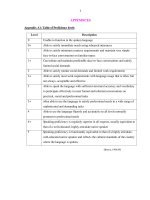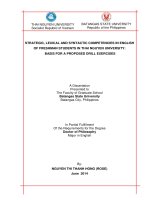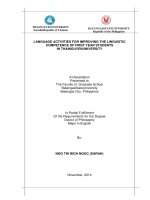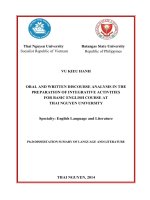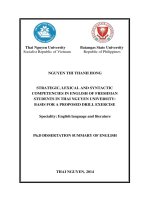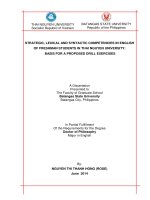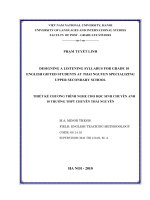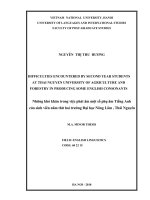complimenting strategies by english-major students at thai nguyen university = các chiến lược khen ngợi của sinh viên chuyên ngành tiếng anh tại đại học thái nguyên
Bạn đang xem bản rút gọn của tài liệu. Xem và tải ngay bản đầy đủ của tài liệu tại đây (730.47 KB, 58 trang )
VIETNAM NATIONAL UNIVERSITY, HANOI
UNIVERSITY OF LANGUAGES AND INTERNATIONAL STUDIES
FACULTY OF POST- GRADUATE STUDIES
TRÂ
̀
N THI
̣
YÊ
́
N
COMPLIMENTING STRATEGIES
BY ENGLISH-MAJOR STUDENTS AT THAI NGUYEN UNIVERSITY
(CC CHIN LƯC KHEN NGI CA SINH VIÊN CHUYÊN NGNH
TIÊ
́
NG ANH TA
̣
I ĐA
̣
I HO
̣
C THA
́
I NGUYÊN )
M.A. MINOR THESIS
FIELD: ENGLISH LINGUISTICS
CODE: 60.22.15
Hanoi-2012
iv
TABLE OF CONTENTS
Page
DECLARATION i
ACKNOWLEDGMENTS ii
ABSTRACT iii
TABLE OF CONTENTS iv
LIST OF ABBREVIATIONS vii
LIST OF FIGURES viii
LIST OF TABLES viii
PART A. INTRODUCTION 1
1. Rationale 1
2. Aims of the Study 2
3. Research Questions 2
4. Significance of the Study 2
5. Scope of the Study 2
PART B. DEVELOPMENT 3
CHAPTER 1. THEORETICAL BACKGROUND 3
2.1. Cross - Cultural Communication 3
2.1.1. Definition of Culture 3
2.1.2. Definition of Communication 3
2.1.3. Definition of Cross - Cultural Communication 3
2.2. Speech Act Theory 4
2.2.1. Definitions of Speech Acts 4
2.2.2. Types of Speech Acts 4
2.2.2.1. Austin‟s Classification 4
2.2.2.2. Searle‟s Classification 4
2.2.2.3. Leech‟s Classification 5
2.2.2.4. Bach and Harnish‟s Classification 5
2.2.2.5. Direct and Indirect Speech Acts 5
2.2.3. Speech Acts across Cultures 6
v
2.3. Politeness 6
2.3.1. What is Politeness? 6
2.3.2. Politeness Strategies 7
2.3.2.1. Maxim Approach 7
a) Grice‟s Cooperative Principle 7
b) Lakoff‟s Politeness Rule 7
c) Leech‟s Politeness Principle (PP) 8
2.3.2.2. Face-management Approach 8
a) Goffman‟s Conceptualization of Face 8
b) Brown and Levinson‟s Politeness Theory 9
2.4. The Speech Act of Complimenting 10
2.4.1. Definition of Compliments 10
2.4.2. Functions of Compliments 10
2.4.3. Complimenting as a Speech Act 11
2.4.4. Compliment Topics 12
2.4.5. Complimenting Strategies 12
2.4.5.1. Basic Complimenting Strategies 12
2.4.5.2. Modifications of Basic Complimenting Strategies 13
2.4.5.3. Direct and Indirect Strategies in Complimenting 13
2.4.5.4. Complimenting Strategies in Terms of Personal Focus 13
2.5. Previous Research on Compliments 13
CHAPTER 2. RESEARCH METHODS 17
2.1. Subjects of the Study 17
2.2. Data Collection Instrument 17
2.3. Data Gathering Procedure 18
2.4. Data Analysis 18
2.5. Research Methods 18
CHAPTER 3. REALIZATIONS OF COMPLIMENTING STRATEGIES 19
3.1. Overall Response Patterns 19
3.1.1. Expressions Preceding the Compliment 19
3.1.2. Expressions Following the Compliment 20
3.2. Category of Complimenting Strategies 21
3.2.1. Basic Complimenting Strategies 21
vi
3.2.2. Combinations of Basic Complimenting Strategies 22
CHAPTER 4. DATA ANALYSIS AND DISCUSSION OF THE FINDINGS 23
4.1. Overall Analysis of the Response Patterns 23
4.1.1. Components of the Response Patterns 23
4.1.2. Comments on the Expressions Preceding and Following the Compliment 25
4.1.3. Use of Complimenting Strategies 28
4.1.4. Interference from Vietnamese Culture to the English-major Students‟
Choice of Complimenting Strategies 29
4.2. Use of Complimenting Strategies with Respect to the Informants 30
4.2.1. American Informants 30
4.2.2. Vietnamese Informants and Vietnamese Learners of English 31
4.3. Use of Complimenting Strategies with Respect to the Communicating Partners 32
4.3.1. When the Communicating Partners are Male Classmates 32
4.3.2. When the Communicating Partners are Female Classmates 33
4.3.3. When the Communicating Partners are Male Teachers 34
4.3.4. When the Communicating Partners are Female Teachers 34
4.4. Use of Complimenting Strategies across Topics 36
4.4.1. Appearance/Possessions 36
4.4.2. Ability/Accomplishment 39
PART C. CONCLUSION 40
1. Summary of Major Findings 40
2. Conclusion 41
3. Pedagogical Recommendations 42
4. Limitation of the Study 43
5. Suggestions for Further Research 44
REFERENCES 45
APPENDIX A. DISCOURSE COMPLETION TEST (English Version) I
APPENDIX B. DISCOURSE COMPLETION TEST (Vietnamese Version) III
vii
LIST OF ABBREVIATIONS
AmE
American English
DCT
Discourse Completion Task
EFL
English as a Foreign Language
F
Face-threatening Acts
FTA
Face Threatening Act
M
Male
TNU
Thai Nguyen University
V
Vietnamese
VE
Vietnamese English
viii
LIST OF TABLES
Tables
Title
Page
Table 1.
Types of expressions preceding the compliment
20
Table 2.
Types of expressions following the compliment
20
Table 3.
Categories of complimenting strategies
21
Table 4.
Combinations of basic complimenting strategies
22
Table 5.
Deviation in the frequency of complimenting strategies between groups
29
LIST OF FIGURES
Figures
Title
Page
Figure 1.
Choices of politeness strategy (Brown and Levinson, 1987)
9
Figure 2.
Bach & Harnish‟s categorization of the speech act of complimenting
11
Figure 3.
Components of the response patterns
24
Figure 4.
Complimenting strategies employed by the three groups of
informants
28
Figure 5.
Complimenting strategies by male and female American informants
31
Figure 6.
Complimenting strategies by male and female Vietnamese informants
32
Figure 7.
Complimenting strategies by male and female Vietnamese learners of
English
32
Figure 8.
Strategies employed to compliment male classmates
33
Figure 9.
Strategies employed to compliment female classmates
33
Figure 10.
Strategies employed to compliment male teachers
35
Figure 11.
Strategies employed to compliment female teachers
35
Figure 12.
Strategies employed to compliment on appearance or possessions
37
Figure 13.
Strategies employed to compliment on ability or accomplishment
39
1
PART A. INTRODUCTION
1. Rationale
Learning a language means more than knowing linguistic features such as the rules of
grammar or the vocabulary system. We must also know how to use a language in its social and
communicative contexts; however, EFL teachers do not often stress pragmatic knowledge in
their classrooms, focusing instead on linguistic knowledge. As a result, even with a high level
of language proficiency and goodwill, learners still have great difficulty making themselves
understood or interpreting properly what is said to them. They even find it extremely difficult
to produce or sometimes understand a speech act such as a compliment, an apology, a request
or a refusal. The mistaken messages they send or receive lead not only to breakdowns in
communication, but also to bad effects within social relationships.
This common problem can also be seen in Vietnamese learners of English. Although they
may have spent a long time studying English and done very well on exams, they can not
communicate effectively with native speakers. The barrier here is cultural awareness. They are
from different cultures, thus have different frames of reference. Failure in communication can
cause what we call “culture shock”. We do things with words as Austin (1962) states. In our
mother tongue and our culture, we face little or no difficulty in employing words appropriately
in order to achieve our aim because we unconsciously follow the norms and conventions of our
speech community.
The speech act of complimenting has been chosen as the topic of the present study
because this speech act is highly representative of face-threatening acts and the realization of
this speech act is largely culture-specific (Gass, 1995; Liao, 1996). People from different
cultures share the same communicative purpose in complimenting each other. However, they
tend to use different patterns and strategies and compliment different attributes. When people
compliment each other in a foreign language, the intended purpose may not be achieved, but
the reverse may occur. In other words, miscommunication or misinterpretation happens when a
user of a foreign language inappropriately compliments others.
In Vietnam, in recent years, much research work has been done into various speech acts;
however, so far very little research has been carried out in Thai Nguyen University where
millions of non-English major students and thousands of English major students are learning
and speaking English. With an effort to fill the gap, we carried out this study as an
investigation into the speech act of complimenting by English-major students at Thai Nguyen
University.
2
2. Aims of the Study
This study aims to find out the preferred strategies by English-major students at Thai
Nguyen University when complimenting in English and to identify the interferences from
Vietnamese culture to the students‟ choice of strategies.
3. Research Questions
The study is intended to address the following questions:
[i]. What are the preferred strategies by English-major students at Thai Nguyen
University when complimenting in English?
[ii]. Is there any interference from Vietnamese culture to the students‟ choice of
strategies when complimenting in English?
4. Significance of the Study
The researcher hopes that this study will be significant theoretically, practically and
pedagogically.
Theoretically, the study may contribute to the theoretical literature by examining the
interferences from Vietnamese culture to the choice of strategies when complimenting in
English by English-major students at Thai Nguyen University.
Practically, the study may reinforce these students‟ awareness of the interferences from
their culture to their choice of strategies when complimenting in English by investigating what
they have already known and what they have not and what proves to be difficult when they are
confronted with the complimenting situations, which may help them achieve a better
performance in cross-cultural communication.
Pedagogically, research in cross-cultural communication including this paper may help
teachers and educators understand the students‟ problems in order to evaluate textbooks and
other teaching materials as well as assessment procedures of language proficiency, to assess
the value of communicative language teaching practices, and to help learners develop
strategies to handle misunderstandings and other communication problems.
5. Scope of the Study
Due to limited time and experience, this study just focuses on verbal communication.
Other factors such as non-linguistic factors (facial expression, gestures, eye contact, etc.),
paralinguistic factors (intonation, pause, speed of speech, etc.) will not be taken into account.
3
PART B. DEVELOPMENT
CHAPTER 1. THEORETICAL BACKGROUND
2.1. Cross - Cultural Communication
2.1.1. Definition of Culture
Today, definitions of culture are multiple and diverse; however, in this paper, culture is
defined and classified for the purpose of the study related to communication. Therefore, out of
the many possible definitions examined, the following definition guides this study: “culture is
a set of shared and enduring meaning, values, and beliefs that characterize national, ethnic, or
other groups and orient their behavior” (Mulholland 1991).
2.1.2. Definition of Communication
Communication can be defined as “the exchange and negotiation of information between
at least two individuals through the use of verbal and non verbal symbols, oral and
written/visual modes, and production and comprehension processes” (Canale, 1983, p. 4). It is
a form of social interaction and involves a high degree of unpredictability and creativity in
form and message.
2.1.3. Definition of Cross - Cultural Communication
According to Clarke and Sanchez, the term ¨cross-cultural¨ implies interaction with
persons of different cultural, ethnic, racial, gender, sexual orientation, religious, age and class
backgrounds. ¨Cross-cultural communication¨ is a process of exchanging, negotiating, and
mediating one's cultural differences through language, non-verbal gestures, and space
relationships. It is also the process by which people express their openness to an intercultural
experience (Clarke and Sanchez, 2001).
Kramsch defined cross - culture as “the meeting of two cultures or languages across the
political boundaries of nation states.” (Kramsch, 1998, p. 81) Thus, cross - cultural
communication is the exchange and negotiation between individuals who come from different
cultural background.
Normally, people know how to behave appropriately within their own culture and
society, but when they move from country to country, this social etiquette changes. For
instance, it is quite usual for Vietnamese people to greet each other by saying “where are you
going?” Such utterance may be perceived as annoying curiosity by native English speakers
because for most Western cultures the individuals and personal privacy come first. For Asian
cultures, nevertheless the emphasis is on promoting group harmony.
2.2. Speech Act Theory
2.2.1. Definitions of Speech Acts
4
The concept of speech acts was first defined by Austin (1975). He did not use the term
speech act, but “performative sentence” or “performative utterance,” which indicated that “the
issuing of the utterance is the performing of an action” (p. 6). The term itself was first used by
Searle (1969) who claimed that “talking is performing acts according to rules” (p. 22), and that
“speech acts […] are the basic or minimal units of linguistic communication” (p.16).
However, Back and Harnish (1979) believed that there is more to a speech act than this.
In their view, speech acts are a complex combination between utterances, locutionary,
illocutionary and perlocutionary acts. Thus, the speech act schema, or SAS, is as follows,
where e is an expression, S the speaker, and H the hearer: “In uttering e [utterance act], S says
something to H [locutionary act]; in saying something to H, S does something [illocutionary
act]; and by doing something, S affects H [perlocutionary act]” (Bach & Harnish, 1979, p. 3).
Wierzbicka (1991) claimed that most of the early definitions of speech acts are
ethnocentric, and that thus they fail to take into consideration what she believed is one of the
most important characteristics of speech acts, namely cultural specificity. She says that, cultural
values and characteristics such as indirectness, objectivism, courtesy, and cordiality are reflected
in the way speakers produce speech acts.
This multitude of definitions also leads to a multitude of taxonomies. This study deals
with the most important classifications of speech acts in the following section.
2.2.2. Types of Speech Acts
2.2.2.1. Austin’s Classification
Austin (1975, p. 151) first classified speech acts into five categories:
- Verdictives provide us with findings and results.
- Exercitives are characterized by the description of powers, rights, and influences.
- Commissives commit the speakers themselves to some future action.
- Behabitives are actions that have to do with „social behaviors‟.
- Expositives develop views, conduct arguments and to clarify the use of references.
2.2.2.2. Searle’s Classification
Communicative approaches to speech act theory mostly categorize speech acts according
to what they communicate to the hearer. Thus, Searle (1976) proposed five types of speech
acts:
- Declarations change the world via their utterance.
- Representatives tell people how and what things are.
- Expressive express feelings and attitudes.
- Directives get someone to do something.
- Commissives commit the speakers themselves to some future action.
2.2.2.3. Leech’s Classification
5
Following this classification, Leech (1983) distinguished speech acts by the verbs that
express them. Thus, speech act verbs can be divided into the following categories: assertive
verbs, directive verbs, commisive verbs, rogative verbs, and expressing verbs.
2.2.2.4. Bach and Harnish’s Classification
Bach and Harnish (1979) classified speech acts in terms of the illocutionary act entailed
into four major types: constatives (assertives, predictives, retrodictives, descriptives,
ascriptives, informatives, confirmatives, concessives, retractives, assentives, disentives,
disputatives, responsives, suggestives, supportives), directives (requestsives, questions,
requirements, prohibitives, permissives, advisories), commissives (promises, offers), and
acknowledgements (apologize, condole, congratulate, greet, thank, bid, accept, reject).
2.2.2.5. Direct and Indirect Speech Acts
The most important problem with these early taxonomies is that, again, they are too
closely linked to the verb that expresses the respective illocutionary act. However, speech acts
can be expressed by other means as well, not only by illocutionary verbs. Therefore, another
approach to distinguish types of speech act can be based on the relationship between the
structure and functions. This approach classifies speech acts into direct and indirect ones.
On one side, direct speech acts are found in utterances that have a homogeneous
relationship between structural forms and communicative functions. According to Yule (1996,
p. 54-55), “Whenever there is a direct relationship between a structure and a function, we have
a direct speech act”.
E.g. “I order you to revise your lessons!” [Direct order]
On the other side, Searle (1975, p. 61) points out:
In indirect speech acts, the speaker communicates to the hearer more than he
actually says by way of relying on their mutually shared background information,
both linguistic and nonlinguistic, together with general powers of rationality and
inference on the part of the hearer.
E.g. “It is very cold in here” [Indirect request to close the windows]
As this section has shown, there are many ways of classifying speech acts by making use
of different criteria.
2.2.3. Speech Acts across Cultures
Speech acts like greeting, complimenting, requesting, thanking or giving advice and so
on are present in almost all cultures. In principle, these speech acts can be fulfilled in any
language, but they are performed in different manners and by different means. Sharing the
same point of view, Hymes (1964) and Saville-Troike (1982) state that there is a close
6
connection between language, society and culture and that all speech acts and speech behaviors
are governed by social norms. That explains why Wierzbicka (1985, p. 146) observes,
“Cultural norms reflected in speech acts differ not only from one language to
another, but also from one regional and social variety to another.” What is more,
“Every culture has its own repertoire of characteristic speech acts and speech
genres.”
(Wierzbicka, 1991, p. 149)
Hence, governed and conditioned by our culture and though the contact with other
members in our cultural environment, everyone sets own “cultural schemata” that helps
him/her interpret what is wrong and what is right. These standards are appropriate in our
community, but when coming into contact with a new culture, if we interpret other‟s behavior
according to these standards, there may be arise some cross-cultural problems in our own
communication that potentially lead to cultural conflict.
Therefore, the study on speech acts across cultures is believed to be essential or vital for
not only a person who expects to survive in a new environment, but also for a learner of a
foreign language who expects to succeed in communication.
2.3. Politeness
2.3.1. What is Politeness?
The notion of politeness has been largely discussed. Lakoff sees politeness as “a system
of interpersonal relations designed to facilitate interaction by minimizing the potential for
conflict and confrontation inherent in all human interchange” (Eden 2001, p. 2). Leech (1983)
defines it as “strategic conflict avoidance, which can be measured in terms of the degree of
effort put into the avoidance of a conflict situation, the establishment and the maintenance of
comity”. Yule specially lists the characteristics of politeness, including “being tactful,
generous, modest and sympathetic toward others” (1997, p. 60). Brown and Levinson (1987)
emphasize politeness as strategies employed by a speaker to obtain a variety of objectives such
as promoting or maintaining harmonious relations. In interaction, there is a narrower type of
politeness at work, which serves as a crucial concept for people to conduct their
communicative behavior.
2.3.2. Politeness Strategies
Leech‟s (1983) conversational maxim approach and Brown & Levinson‟s (1987) face-
management model are the two most influential approaches in politeness literature.
Nevertheless, one perspective has often been pitted against the other in terms of its
effectiveness for explaining certain phenomena (Mao, 1994). Thus, these two approaches have
been selectively chosen and will be analyzed in depth.
2.3.2.1. Maxim Approach
7
The maxim approach relies heavily on Gricean pragmatics in trying to answer the
question how people mean more than they say. The main adherents to this view are Lakoff
(1973) and Leech (1983).
a) Grice’s Cooperative Principle
Paul Grice (1967) proposes that in ordinary conversation, speakers and hearers share a
cooperative principle, the content of which is to “make your conversational contribution such
as required, at the stage at which it occurs, by the accepted purpose or direction of the talk
exchange in which you are engaged”. Grice has proposed what has been known as the
Cooperative Principle (hereafter, CP). From this CP, Grice advances four sub-maxims:
“quality, quantity, relevance, and manner” and articulates that violation of one or more of these
conversational maxim(s) may implicate certain speaker intentions.
Quantity:
1. Make your contribution as informative as required.
2. Do not make your contribution more informative than is required.
Quality:
1. Do not say what you believe to be false.
2. Do not say that for which you lack adequate evidence.
Relation:
1. Be relevant.
Manner:
Be perspicuous
1. Avoid obscurity of expression.
2. Avoid ambiguity.
3. Be brief (avoid unnecessary prolixity)
4. Be orderly.
b) Lakoff’s Politeness Rule
Grice‟s cooperative principle served as the starting point of Lakoff‟s “Politeness Rule”.
The more you seek to communicate your message directly to achieve full clarity, the more you
move away from an expression of politeness; hence, clarity and politeness were seen as
opposites in her rule. Lakoff introduces the interpersonal rule “be polite” to supplement CP.
Her interpersonal politeness rule consists of three sub-rules: (1) do not impose, (2) give
options, and (3) make the addressee feel good.
c) Leech’s Politeness Principle (PP)
Leech chooses to discuss politeness within the framework of “Interpersonal Rhetoric”.
Interpersonal Rhetoric is related to a speaker‟s social goals (what social position a speaker
takes) rather than illocutionary goals (what a speaker tries to convey through a speech act).
Within this domain, Leech (1983) establishes six -paired- maxims associated with the
Politeness Principle:
Tact maxim: Minimize cost to other. Maximize benefit to other.
8
Generosity maxim: Minimize benefit to self. Maximize cost to self.
Approbation maxim: Minimize dispraise of other. Maximize dispraise of self.
Modesty maxim: Minimize praise of self. Maximize praise of other.
Agreement maxim: Minimize disagreement between self and other. Maximize
agreement between self and other.
Sympathy maxim: Minimize antipathy between self and other. Maximize sympathy
between self and other.
Despite its very detailed elaboration, Leech‟s model remains abstract for some
researchers.
2.3.2.2. Face-management Approach
Politeness as a linguistic theory was first systematized by the face saving view that has
been proposed by Brown and Levinson in their book Politeness: Some Universals in Language
Usage. However, their theory springs from Goffman‟s conceptualization of face.
a) Goffman’s Conceptualization of Face
Goffman (1959) considered “face” as the “positive social value a person effectively
claims for himself by the line others assume he has taken during a particular contact”.
Goffman (1967) repetitively lays emphasis on the fact that there is a two-way face
orientation in interaction. A person is not only concerned with his/her own face but is also
expected to show concern for others‟ feelings to uphold their face for emotional identification
with others‟ feelings.
Goffman also posited the ideas of negative face and positive face, where negative face
means the speaker wants to be free and independent from society. This speaker would be less
likely to follow rules of politeness because he doesn‟t care about society‟s perception of his
face. Positive face, in turn, means the speaker wants to be seen and accepted positively in
society, and would be more likely to participate in the rules of politeness.
b) Brown and Levinson’s Politeness Theory
Brown and Levinson‟s (1987) define a threat to a person's face as a Face Threatening Act
(FTA), and argue that such threats generally require redress: a mitigating statement or some
verbal repair (politeness), or breakdown of communication will ensue. They propose four
kinds of FTAs:
(i) Acts threatening to the hearer‟s negative face by indicating (potentially) that the
speaker does not intend to avoid impeding hearer‟s freedom of action (e.g. ordering,
suggesting, threatening, warning, offering, promising, complimenting).
(ii). Acts threatening to the hearer‟s positive face by indicating (potentially) that the
speaker does not care about the addressee‟s feeling, wants, etc. – that in some important
9
respect, he does not want hearer‟s wants (e.g. disapproving, contempting, complaining,
criticizing, disagreeing, accusing and raising taboo topics).
(iii). Acts threatening to the speaker‟s negative face (e.g. accepting an offer, accepting
thanks, excusing, promising unwillingly).
(iv). Acts threatening to the speaker‟s positive face (e.g. apologizing, accepting
complimenting, and confessing).
Brown and Levinson (1987) also present five super-strategies of politeness illustrating
different levels of politeness in connection to the FTA and redress (attempts to counteract the
potential face damage of the FTA) made, if any. This is explained visually below:
Figure 1. Choices of politeness strategy (Brown and Levinson, 1987)
Another important key concept for their theory that needs to be introduced is
“weightiness” which is related to three sociological variables. Assessing the seriousness of
certain illocutionary acts that can damage a persons face, FTAs, involves making an
assessment of the social parameters related to:
(i) Social distance (D) of S and H; the degree of familiarity and solidarity they share.
(Leech‟s “horizontal distance”)
(ii) Relative power (P) of S and H; the degree to which the speaker can impose will on
the hearer. (Leech‟s “authority”)
(iii) Ranking of imposition (R) attached to the speech act in the culture; the degree of
expenditure of goods and services by the hearer; the right of the speaker to perform the act; and the
degree to which the hearer welcomes the imposition. (Leech‟s “costliness”)
2.4. The Speech Act of Complimenting
2.4.1. Definition of Compliments
A dictionary definition of compliment describes compliment with three kinds of meanings:
they are remarks that express admiration of someone or something; they are remarks that show
Greater
Lesser
10
that we trust someone else and have a good opinion of them; they are remarks that express
praise, or good wishes (Longman Dictionary of Contemporary English, 2004)
Some researchers have made some definitions about compliments, among which the most
famous and standard one is Holmes‟ version. Holmes (1986, p. 485) identifies the compliment
as a positively affective speech act, where the speaker “explicitly or implicitly attributes credit
to someone other than the speaker, usually the person addressed, for some “good” (possession,
characteristic, skill, etc.) which is positively valued by the speaker and hearer.” Olshtain and
Cohen added “the speech act of complimenting is intrinsically courteous and enables the
speaker to make use of available opportunities to express and interest in the hearer” (1991, p.
158).
E.g. That is a nice suit you have on.
2.4.2. Functions of Compliments
The functions of compliments are varied. In this study, the author summarizes the functions
of the compliment in other researchers‟‟ works and divides them into six types:
To express admiration or approval of someone‟s work/appearance/taste (Herbert,
1998).
To establish/confirm/maintain solidarity (Wolfson, 1989).
To replace greetings/gratitude/apologies/congratulations (Wolfson, 1983).
To soften face-threatening acts such as apologies, requests and criticism (Wolfson,
1989). If the speaker makes some offence to the hearer, he could use a compliment to
change the topic and soften the tense atmosphere.
To open or sustain conversation (Wolfson, 1983).
To reinforce desired behavior (Manes, 1983).
2.4.3. Complimenting as a Speech Act
The speech act of complimenting appears in Austin‟s classification under the class of
„behabitives‟. Austin describes this class as reactions “to other people's behaviour and
fortunes,” embodying "expression of attitudes to someone else's” conduct or qualities (1962, p.
159). More specifically, he views compliments as a means of expressing sympathy along with
congratulations, condolences and felicitations.
Later descriptions in Speech Act Theory follow the same line. Bach and Harnish, for
example, group complimenting as a subcategory of congratulations along with condolences
and felicitations (1979, p. 52). They thus fall under their class of acknowledgements, which
express some positive or negative attitude towards others (see Figure 1).
11
According to Bach & Harnish‟s classification, the communicative illocutionary act of
complimenting is categorized as follows:
Figure 2. Bach & Harnish‟s categorization of the speech act of complimenting
Even though Searle (1976) does not mention complimenting in his categories of
illocutionary acts, they would probably be grouped under „expressives‟, which communicate
the speaker‟s attitude to a certain state of affairs. While compliments have been grouped with
congratulations, little comparison has been made between the two acts. Searle (1969, p. 67)
describes congratulations as expressing the speaker‟s pleasure regarding some event related to
the hearer (cf. also Bach and Harnish 1979). While the same positive reaction is also relevant
in compliments, compliments present personal assessments of a situation. Searle‟s (1976)
criteria for classification of speech acts would also bring them into the class of
„representatives‟ (assertives) since compliments express the speaker‟s belief in a proposition.
For example, a compliment such as 'What a beautiful picture!‟ expresses both a positive
reaction and an assessment of the object, and may be responded to with, say, „Yeah‟ or „Do
you really think so?‟. In other words, one can agree or disagree with the proposition in the
compliment. Since expressives are mainly reactions to a situation, it should not be possible to
utter an agreement or disagreement. In response to a congratulation on having received a prize
in a contest, for example, it is possible to deny the worth of the achievement, but it is not
possible to deny having received the prize. This brief excursion into the semantics of
compliments is not to deny their social function but to reveal the source of the latitude
recipients of compliments have in formulating their responses: The complimentee may respond
to either the assertive or the expressive illocutionary force of the utterance.
2.4.4. Compliment Topics
Constatives
Directives
Commisives
Acknowledgements
Congratulate
Compliment
Praise
Congratulate
Communicative Illocutionary Acts
12
A topic may properly serve as the focus of a compliment. In spite of the broad range of
topics found in some research, the majority of compliments are restricted to only a few general
topics. Based on the U.S. data, Manes and Wolfson (1981) and Wolfson (1983) observed that
compliments seem to fall naturally into two general categories - those which focus on
appearance and/or possessions, and those which have to do with ability and/or
accomplishments. "Appearance", in this sense, refers to one's looks, including clothing,
haircuts, ornaments, and so on. "Possessions" refers to material possessions such as furniture,
automobiles. "Ability" refers to the "quality of something produced through the addressee's
skill or effort: a well-done job, a skillfully played game, a good meal (Manes, 1983, p. 101)".
"Accomplishments" refers to one's acquired skill.
2.4.5. Complimenting Strategies
2.4.5.1. Basic Complimenting Strategies
(i) Admiration expression is an expression containing a positive evaluation either
explicitly (e.g. You are beautiful) or implicitly (e.g. You have to tell me the secret of your new
look).
(ii) Appreciation expression is an expression which shows the gratitude towards the
others (e.g. Oh. Thank you. I really appreciate it).
(iii) Feeling expression is an expression of feelings towards the others such as happiness,
prayer, kindness, wishing to keep in touch and being proud (e.g. I‟m proud of you).
2.4.5.2. Modifications of Basic Complimenting Strategies
(i) Intensity of a compliment or compliment response is realized by intensifiers such as
very, by combinations and by repetition of the same strategy.
(ii) Expansion is realized by proverb, promise, invitation, comments, assurance by
swearing, negation or imperatives.
(iii) Emotional is realized by interjections (e.g., Oh!) or invocations (e.g., God!),
exclamation (e.g., Wow) or endearment such as Dear!.
2.4.5.3. Direct and Indirect Strategies in Complimenting
Direct compliments are expresses to the person being complimented.
E.g. Mm, you‟ve got a new jumper. It‟s beautiful!
Indirect compliments are “overtly addressed to one person but actually compliment
another party who is present.”
E.g. Your friend seems very nice, dear. (Holmes, 1988, p. 486)
13
2.4.5.4. Complimenting Strategies in Terms of Personal Focus
According to Herbert (1990), compliments can be analyzed in terms of types of personal
focus. There are three types of compliments in terms of personal focus:
(i.) 1
st
person focus: e.g. I like your hair that way.
(ii.) 2
nd
person focus: e.g. Your hair looks good short.
(iii.) 3
rd
person focus (impersonal): e.g. Nice haircut!
Yan (2008) classified politeness strategies used in English compliments and by Han,
Kazak, and Uygur EFL Learners in terms of personal reference as follows:
(i.) Speaker-oriented: “I, we”
(ii.) Hearer-oriented: “you”
(iii.) Topic-oriented: “it, our view, your cell phone, his suit”
2.5. Previous Research on Compliments
Compliments have been recently studied by many researchers. Most studies have focused
on spoken discourse (Wolfson & Manes 1980; Wolfson 1981, 1983; Manes 1983s; Holmes
1988; Herbert 1990) in which data were mainly obtained through fieldwork and
questionnaires. Some others focused on written discourse. These studies have looked at
compliment formulae, lexical distribution, cultural values, gender differences, and the status of
complimenters and recipients.
Wolfson & Manes (1980) focused on the way in which compliments were used in
different social situations. The analysis was based on 950 compliments gathered in everyday
interactions. The hypothesis was that the basic function of compliments was to create and
maintain solidarity, and that was why people tended to use formulae to express their
compliments.
E.g. Thanks for the card. We really like it. (Wolfson, 1983, p. 88)
Lexical distribution has been investigated by Manes and Wolfson (1980). It was reported
that 80% of all compliments were the adjectival type in which the two most frequently used
adjectives were nice and good, accounting for 42%. The other three most frequent adjectives
were beautiful, pretty, and great. Two verbs, like and love, accounted for 90% of the
compliments where a verb was used. In Holmes‟s New Zealand data (1987), the five most
frequently used adjectives were nice, good, beautiful, lovely, and wonderful; and the verbs like,
love, enjoy, admire and be impressed by accounting for 80 % of the data.
14
More recent research has looked at gender differences. Wolfson (1983, p. 92) mentioned
“women appear both to give and receive compliments much more frequently than men do”.
Holmes (1988) examined compliments given by New Zealand people. The research focused on
gender differences in complimenting. Data consisted of 488 compliments and compliment
responses which were collected from naturally occurring exchanges. The hypothesis was that
there were differences in the way women and men gave compliments. Holmes also pointed out
that women gave and received more compliments than men did, and both women and men
complimented women more than they did men. With respect to topics of compliments, Holmes
showed that women tended to compliment each other on appearance whereas men tended to
compliment on possession.
Regarding status of compliment givers and compliment receiver, research results have
shown that most compliments occur between status equals. As Wolfson (1983, p. 91) puts it,
“the overwhelming majority of all compliments are given to people of the same age and status
as the speaker”. Many researchers have reported the same pattern (Knapp, Hopper and Bell
1984; Holmes 1988; Herbert 1990). However, in New Zealand data, Holmes (1986) found that
higher status females were twice as likely to receive compliments as higher status men, and
that men were even more likely to compliment women of higher status than women were. This
is further support for the view that it is more acceptable to compliment high status women than
high status men. This interpretation of the patterns observed is consistent with the suggestion
that higher status women are perceived as more receptive to compliments than their male
counterparts are, because in society as a whole, women are generally regarded as socially
subordinate and less powerful and influential than men (Holmes 1988). Alternatively, women
are seen as more approachable because they value solidarity more highly than status, and tend
to reduce rather than emphasize status differences. Based on the results, Holmes (1988)
concluded that in New Zealand, women tend to use compliments as solidarity signals, but men are
more likely to experience them as FTAs.
Social researchers have looked at how culture may influence compliments. Wolfson
(1981) provided a description of semantic and syntactic structure of compliments in American
English, and comparisons were made with compliments given by non-native speakers of
English. Wolfson supported the idea that speech acts differ from community to community in
their realization patterns and in functions; therefore, sociolinguistic descriptions of language in
use are very important and necessary. Manes (1983, p. 98) discussed how cultural values were
15
expressed in compliments, mentioning that “if we wish to be approved of and complimented,
we must conform to the extent of doing things which others will recognize as worthy of
compliments”. Newness was also mentioned as the most important of cultural values reflected
n compliments. People tended to compliment on the results of work achieved and on
appearance, especially on women‟s but not on natural attractiveness.
Discussing on compliments in Asian countries, as stated by Kartomihardjo (1987), a
speaker needs to be careful in expressing compliments to another person because for Asian
people, compliments are not quite common. According to his perspective, a close relationship
between the speaker and the recipient is an important condition before compliments are
expressed. The closer the relationship both of them possess, the more openness they have in
stating their compliments to one and another.
A study of complimenting speech act in Australian English and Vietnamese was done by
Suu (1990). The findings showed that similar syntactic patterns of compliments were used in
English and Vietnamese, but the topics of compliments were different from one language to
the other.
Thai Thi Ngoc Lien (1993) carried out the research: “Complimenting in English and
Vietnamese”. The study investigates how compliments are expressed in English and
Vietnamese, and at the same time examines the influence of students‟ mother tongue and
culture on the target language speech act performance. Its aim is to provide Vietnamese
learners of English with sociolinguistic information which will enable them to compliment in
the target language. Data were collected through questionnaire and role play. The population
from the subjects are drawn include Australian native speakers of English, Vietnamese
informants of English in Vietnam and Vietnamese students in Canberra.
Le Phuong Binh (2008) in “A Vietnamese-English Cross-Cultural Study of Positive
Politeness and Negative Politeness in Complimenting” points out the use of Positive Politeness
and Negative Politeness strategies in complimenting by English native speakers and
Vietnamese ones.
The most famous in-depth research was carried out by Nguyen Van Quang (1999) under
the title “Some Cross Cultural Differences in Vietnamese and American Ways of
Complimenting and Responding to Compliments”. The research investigated some major
differences in giving and responding to compliments in intercultural Vietnamese-American
16
communication with the main focus on compliment topics, responding strategies, addressing
forms, directness vs. indirectness, and modality.
From the above literature review, we can see that although there have been many studies
investigating the speech act of complimenting in Vietnam, none of them has focused on
cultural interference and especially, none of them was carried out in Thai Nguyen. It is hoped
that this study will make a contribution to this area of inquiry based on insights derived from
the literature and the data obtained from the questionnaires.
17
CHAPTER 2. RESEARCH METHODS
This chapter is concerned with the selection of subjects and the instruments of collecting
data. It describes in some detail the design of the instruments and the descriptive quantitative
procedures that were undertaken for analysis of the data.
2.1. Subjects of the Study
Data were collected from three groups of subjects:
Group 1: 30 Vietnamese learners of English who are learning at TNU in their fourth year.
Their age ranges from 22 to 23. Their English is of advanced level. The researcher chose these
subjects on the assumption that these students have acquired proficiency of English that
ensures familiarity with various speech acts and is good enough to make them understand and
respond to various situations.
Group 2: 16 American native speakers of English who are studying at St. John‟s
University, New York. Their age ranges from 22 to 23.
Group 3: 30 native Vietnamese speakers. They are studying different majors other than
English in their fourth year at TNU. Their age ranges from 22 to 23. The reason why I choose
these subjects is that I wish to get rid of the reverse transfer from the foreign language
(English) to their first language (Vietnamese) which might happen if they know English fairly
well.
In all groups, the numbers of males and females were evenly distributed.
2.2. Data Collection Instrument
Having reviewed the relevant literature, the researcher has found that there were two
different ways to collect data: audio-visual instruments and discourse completion test (DCT).
However, the researcher chose the DCT because this instrument has some characteristics that
make it most suitable for eliciting the data required. It is a controlled elicitation procedure for
collecting the data necessary to represent socially differentiated situations. Lorenzo-Dus
(2001) states that DCT enables the researcher to obtain sufficient data in a relatively short
period of time.
In this study, the DCT consists of 4 situations which are formulated in relation to five
characterizations:
(i) Due to limited time and experience, this study just focuses on communication taking
place within the university scope; therefore, the interlocutors are students and teachers only.
(ii) Compliment topics: appearance, possession, ability and accomplishment.
18
(iii) Social status: equal status between classmates; different status between students and
teachers.
(iv) Social Distance: in all the situations the interlocutors are familiar with each
other, i.e. they know each other very well.
(v) Interlocutors‟ gender: male and female.
These characterizations are necessary to provide useful information for analyzing and
comparing the data for the purposes of this study.
2.3. Data Gathering Procedure
The procedure of gathering data for this study follow three steps:
First, the DCT in English is pilot-tested with a group of ten native English speakers at St,
John‟s University (Pilot Group). The goal of the pilot test was to establish the contextual
appropriateness of the items in eliciting the speech acts under study, i.e. to check whether the
completion items indeed elicit requests and apologies. Dialogues that do not prove to be
sufficiently delimited contextually are slightly changed. The resulting DCT questionnaires will
be then ready for the data collection.
Secondly, the resulting version is administered to another 15 American native speakers of
English who are studying at St. John‟s University, New York (Group 2). Then, the DCT is
administered to 30 Vietnamese learners of English at TNU (Group 1).
Thirdly, the DCT is translated into Vietnamese, and then delivered to 30 native
Vietnamese speakers (Group 3) to fill in with compliments in Vietnamese.
2.4. Data Analysis
In analyzing complimenting strategies in English and Vietnamese, the researcher
computes the frequency of use of these strategies.
The major discussion focused on the preferred strategies by English-major students at
Thai Nguyen University when complimenting in English and the interferences from
Vietnamese culture to the students‟ choice of the strategies.
2.5. Research Methods
The researcher used both quantitative and qualitative methods to investigate the data.
Qualitative method involves the referring of relevant materials such as books, articles, website,
and the review of previous studies. Quantitative method refers to the statics of the data
collection and analysis basing on certain situations with participants of the study.
19
CHAPTER 3. REALIZATIONS OF COMPLIMENTING STRATEGIES
All together 1216 responses were collected from 30 Vietnamese native speakers (group
V), 16 American English native speakers (group AmE) and 30 English-major students at Thai
Nguyen University (group VE). The first analysis concerns overall response patterns. The
second section focuses on the complimenting strategies.
3.1. Overall Response Patterns
As has been noted by Wolfson and Manes (1980), most of the responses often consist of
three components:
- Expression preceding compliment (Pre.C)
- Compliment (C)
- Expression following compliment (Post.C)
E.g. Congratulation! Your presentation is very interesting. Keep it up.
Pre.C C Post.C
The core component is the compliment. A response may have all these three components,
the compliment and either of the others, or just the compliment only. They can be one of these
following types:
(i.) Pre.C + C + Post.C
E.g. I noticed you for a new haircut! I think that it looks really nice and it suits you really
well. Where did you get it done?
(ii.) Pre.C + C
E.g. Did you just get a new hair cut? It looks good!
(iii.) C + Post.C
E.g. I really like your new haircut. Where did you get it done?
(iv.) The C-only
E.g. Great…haircut!
What a nice haircut!
3.1.1. Expressions Preceding the Compliment
From the Vietnamese, Vietnamese English and American English corpus, types of the
expressions preceding the compliment can be listed with examples for each type as shown in
Table 1.

